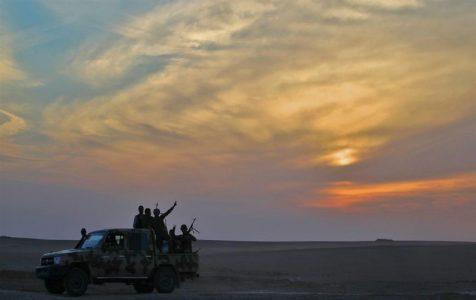
Islamic State terrorists are coming back in Kirkuk?
In the last week of December, an armed group ambushed a convoy on the Kirkuk-Hawija road in Iraq, killing seven people. Iraqi security forces couldn’t track the attackers. The identities of those killed were determined quickly: They were Col. Fazil Sebawi of the Iraqi police, his son and five bodyguards.
Shortly afterward, reports of another attack came from south of Kirkuk. Walid Nuri, the leader of the Jiheshad tribe and commander of Hashd al-Ashayer forces southwest of Kirkuk, his wife and son were killed.
Nobody could explain the attacks. After ousting Kurdish forces from Kirkuk, the Iraqi army and Popular Mobilization Units (PMU) had imposed total control over the area and ensured its security. However, the Islamic State (IS) soon claimed responsibility for both attacks.
After seizing Mosul in 2014, IS had turned toward Kirkuk but was repelled by Kurdish forces controlling the town. Yet, possibly because of the region’s oil wealth, IS never gave up on Kirkuk. Although the extremist group couldn’t control the city center, its influence over the province’s southern regions never waned.
Although IS was not active after it left Kirkuk, it resurfaced after the Iraqi army took control of the region. Iraqi forces went after the IS militants, killing 10 of them in two attacks. Six militants were killed, three in Sadiye and three in Beshir villages. Military commander of Kirkuk army operations announced the six killed were the attackers who had staged the two attacks.
But how did IS resurface even after the region came under the total control of the Iraqi army and the PMU? Security sources in the region, who asked not to be identified, said IS has resumed operations south of Kirkuk. They said sleeper cells of the group have been reactivated and are preparing for new operations.
According to Sahawan Abdullah, an Iraqi member of parliament from Kirkuk and head of the parliamentary Security Commission, IS units have infiltrated Kirkuk.
“There have been explosions and kidnappings in Kirkuk. The last [attack] involved the abduction of four Kurds in an Arab village. There have been similar incidents at the Dakuk border. Although Shiite militias are responsible for some these incidents, others are carried out by IS,” Abdullah told Al-Monitor. “There is a vacuum because we don’t have Kurdish security forces. The Kirkuk-Hawija border is empty now without any military presence. We heard IS has penetrated Kirkuk from the Hawija area. IS elements are freely moving between Rashad-Dakuk-Tuz Khormato without encountering any Iraqi army.”
Abdullah believes that the central government cannot secure the area by itself and that a joint security force has to be set up. “Today conditions in the area are like those in the days of Saddam Hussein. It is very bad. There must be joint efforts by peshmerga forces and security units as in the days before IS,” he said.
Shiwan Dawudi, a member of parliament from Patriotic Union of Kurdistan, says even if IS has lost territory, it is still active. Dawudi told Al-Monitor, “True, IS has lost territory but the organization is still alive, their militants are around. For example, there were 2,000-2,500 armed IS militants in Hawija. But after the liberation of Hawija, about 300 IS militants were captured dead or alive. What happened to the rest? Where did they go? They retreated to the mountains and valleys around Kirkuk. … Some joined sleeper cells and some hid among the people. They reorganized after a few months and resumed operations. Their action style has changed as well. They now want quality operations, Like guerrillas, they launch hit-and-run operations.”
According to Dawudi, the sleeper cells only provide logistical support. He insists the absence of Kurdish security forces from Kirkuk has created a vacuum. “Sleeper cells take care of their needs while IS militants carry out operations. They pose as local people. In previous years, Kurdish security forces were responsible for the security of Kirkuk. They had impressive intelligence sources. They knew IS sympathizers.
They were even able to classify the people in refugee camps as IS or friends. But after Oct. 16, the governor of Kirkuk was replaced. Because there are no security forces inside Kirkuk, there is a vacuum that IS benefits from. IS today has become an organization active in Baghdad and Kirkuk,” he added.
After Kirkuk, Hawija was the location where IS was most powerful. On Oct. 5, when IS was expelled from Kirkuk province, everyone felt good but that lasted only three months. The nightmare can resume any moment with different tactics. IS militants, who earlier fought in towns and did not withdraw until the last moment, have used hit-and-run tactics in the last two operations, as noted by Dawudi.
If IS adopts this guerrilla warfare style, everything could start over. IS does not want to give up Kirkuk and the Iraqi army and international forces do not want to ease up on IS. With guerrilla warfare tactics, this war could go on for years as both the societal and political environments are conducive to it.
Source: Al Monitor





